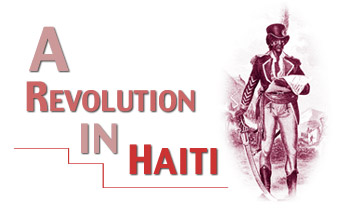At the outbreak of the French Revolution in 1789, the colony of St. Domingue, now Haiti, furnished two-thirds of France’s overseas trade, employed one thousand ships and fifteen thousand French sailors. The colony became France’s richest, the envy of every other European nation. This plantation system, which provided such a pivotal role in the French economy, was also the greatest individual market for the African slave trade. Yet, conflict and resentment permeated the society of San Domingo, and slave resistance began to take an organized form in the late 18th century. The French Revolution did inspire many in 1789, but black resistance had existed for years. In August of 1791 an organized slave rebellion broke out, marking the start of a twelve-year resistance to obtain human rights. The Haitian Revolution is the only successful slave revolt in history, and resulted in the establishment of Haiti, the first independent black state in the New World.
 One must emphasize the struggles that had been occurring for decades prior to the 1791 outbreak of full-scale rebellion. Yet the French Revolution was also crucially important, for the conflicts between whites about what exactly its ideals meant triggered an opportunity for blacks. A historically significant step was the issuance of the Declaration of Rights of Man passed in France on August 26, 1789. It stated, "In the eyes of the law all citizens are equal." While the French government did not want to release this to their colonies, word got out. News of the Declaration of Rights of Man brought new hopes to the black masses. Meanwhile, plantation owners and the French government continued to exploit the slaves for profit. One must emphasize the struggles that had been occurring for decades prior to the 1791 outbreak of full-scale rebellion. Yet the French Revolution was also crucially important, for the conflicts between whites about what exactly its ideals meant triggered an opportunity for blacks. A historically significant step was the issuance of the Declaration of Rights of Man passed in France on August 26, 1789. It stated, "In the eyes of the law all citizens are equal." While the French government did not want to release this to their colonies, word got out. News of the Declaration of Rights of Man brought new hopes to the black masses. Meanwhile, plantation owners and the French government continued to exploit the slaves for profit.
A series of revolts occurred in 1790, by mulattoes led by Vincent Ogé. Descendents of mixed blood were trying to establish suffrage from a recent National Assembly ruling. However the white Colonial Assembly ignored French efforts. These mulatto-led revolts were the first challenges against French rule and the slaveholding system. In August of 1791, the first organized black rebellion ignited the twelve-year San Domingo Revolution. The northern settlements were hit first, and the flood that overwhelmed them revealed the military strength and organization of the black masses. Plantations were destroyed, and white owners killed to escape the oppression. Some of the rebellion’s leaders include Boukman, Biassou, Toussaint, Jeannot, Francois, Dessalines, and Cristophe. These men would help to guide the Revolution down its torturous, bloody road to complete success, although it would cost over twelve years and hundreds of thousands of lives. Many of those leaders themselves would fall along the way, but the force of unity against slavery, a unity deeply embedded in the creole culture that bound the blacks together, would sustain the revolution.
After the revolutionaries’ initial successes in overwhelming the institution of plantation slavery on the Plaine du Nord, Le Cap fell into the hands of French republican forces. Toussaint and thousands of blacks joined them in April 1793. The agreement was if the blacks fought against the royalists, the French would promise freedom. Thus, on August 29, 1793, Commissioner Légér-Felicité Sonthonax abolished slavery in the colony. Then with self-interest in mind, revolutionary France’s British enemies tried to seize an opportunity to grab the colony, so recently the greatest single source of colonial wealth in the whole world. Furthermore, the British wanted to put down the slave rebellion in order to protect their own slave colonies.
 In June of 1794 British forces landed on the island and worked with Spain to attack the French. Yet, the British forces soon fell victim to yellow fever. With more uncertainties presenting themselves, Toussaint decided to pledge his support to the French, on May 6, 1794. Toussaint was appointed governor in 1796 and he continued to follow his ideas for an autonomous black- led San Domingo. By January 1802, Toussaint was the head of a semi-independent San Domingo. Napoleon saw this as a threat and sent his brother-in-law Victor-Emmanuel Leclerc from France with 20,000 troops to capture Toussaint, and re-establish slavery in the colony. Toussaint was deceived in 1802, captured and shipped to France, where he eventually died in prison. In June of 1794 British forces landed on the island and worked with Spain to attack the French. Yet, the British forces soon fell victim to yellow fever. With more uncertainties presenting themselves, Toussaint decided to pledge his support to the French, on May 6, 1794. Toussaint was appointed governor in 1796 and he continued to follow his ideas for an autonomous black- led San Domingo. By January 1802, Toussaint was the head of a semi-independent San Domingo. Napoleon saw this as a threat and sent his brother-in-law Victor-Emmanuel Leclerc from France with 20,000 troops to capture Toussaint, and re-establish slavery in the colony. Toussaint was deceived in 1802, captured and shipped to France, where he eventually died in prison.
But the struggle for independence continued and by late 1803 the north and south arenas of the island united and defeated the French under Rochambeau. Dessalines, Toussaint’s former lieutenant proclaimed the independence of the country of Haiti and declared himself Emperor. He was assassinated in 1806, and the country divided between rival successors. Yet, the rebels had shattered the enslaved colony and forged from the ruins the free nation of Haiti.
|






